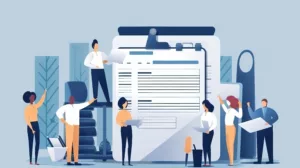Introduction
In recent years, the landscape of higher education has shifted towards a more digital and flexible learning environment. Asynchronous communication, a form of communication that does not require participants to be present simultaneously, has become a critical aspect of modern learning methodologies (Hrastinski, 2008). This paper examines the benefits of enhancing asynchronous communication between academics, students, and student peers in university settings, supported by relevant literature and research findings.
Benefits of Asynchronous Communication to Academics
Flexibility and Time Management
Asynchronous communication offers increased flexibility to academics, as they can engage with students on their own schedules, thereby managing their workload more effectively (Simonson et al., 2011). This flexibility allows for more in-depth, reflective responses and thoughtful engagement in discussions, which ultimately improves the quality of feedback provided to students (Moore, 2014).
Cultivating a Sense of Community
Enhancing asynchronous communication between academics and students fosters a sense of community within online learning environments (Rovai, 2002). By promoting active participation, asynchronous communication tools like discussion boards can help develop social presence, promoting a sense of belonging and encouraging meaningful interactions between students and faculty (Garrison et al., 2000).
Benefits of Asynchronous Communication to Students
Improved Learning Outcomes
Asynchronous communication has been shown to improve learning outcomes by providing students with opportunities to engage with course material at their own pace (Hrastinski, 2008). Research indicates that students who participate in asynchronous discussions demonstrate higher levels of knowledge construction, critical thinking, and overall performance compared to students who engage solely in face-to-face interactions (Schellens & Valcke, 2006).
Enhanced Collaboration and Peer Learning
Asynchronous communication supports collaboration and peer learning among students, as it allows for more structured and thoughtful interactions (Johnson et al., 2000). Collaborative learning is known to enhance students’ problem-solving and decision-making skills, as well as their understanding of complex concepts (Laal & Ghodsi, 2012).
The Impact of Asynchronous Communication on Student Engagement
Reducing Transactional Distance
Enhancing asynchronous communication can help reduce transactional distance, a concept that refers to the psychological and communication gap between students and instructors in distance education settings (Moore, 1993). By fostering more frequent and meaningful interactions between students, peers, and faculty, asynchronous communication can contribute to a more engaging and supportive learning environment (Saba, 2000).
Inclusivity and Equity
Asynchronous communication allows for more inclusive learning experiences, as it accommodates diverse learners with different learning preferences, time constraints, and geographical locations (Picciano, 2002). This inclusivity can contribute to greater equity in educational opportunities and outcomes for all students (Jaggars & Xu, 2016).
Future Research Directions
Future research should continue to explore the impact of asynchronous communication on student learning, engagement, and satisfaction in various contexts and disciplines. Additionally, research should investigate the potential of emerging technologies, such as artificial intelligence and virtual reality, to further enhance asynchronous communication and contribute to the evolution of higher education.
Conclusion
Asynchronous communication plays a crucial role in enhancing the learning experience in higher education institutions. By providing flexibility, fostering a sense of community, and promoting collaboration, asynchronous communication supports improved learning outcomes, increased student engagement, and greater inclusivity. It is essential for universities to invest in the development and implementation of effective asynchronous communication tools and strategies to ensure the success and well-being of both academics and students.
Case StudY
The following case studies illustrate the practical application and impact of enhancing asynchronous communication in higher education settings. These real-life examples provide insights into the challenges, strategies, and outcomes associated with implementing asynchronous communication tools in diverse learning environments. By examining the context, implementation, and outcomes of each case study, we aim to offer valuable guidance to educators, administrators, and students seeking to harness the benefits of asynchronous communication in university courses.
Case Study 1: Enhancing an Online Business Course
Context
A large public university implemented an online business course designed for undergraduate students. The course had a diverse student population, including working adults, international students, and individuals with family commitments. The faculty aimed to foster a collaborative learning environment while accommodating students’ varying schedules and needs.
Implementation
To enhance asynchronous communication in the course, the faculty introduced a combination of discussion boards, wikis, and peer-review activities. They provided clear guidelines for participation, established response times, and set expectations for netiquette. The faculty also offered training and resources to students, such as tutorials and technical support, to ensure effective use of asynchronous communication tools.
Throughout the semester, faculty actively participated in discussions, provided feedback, and monitored students’ progress. They also encouraged students to share their experiences, insights, and resources with their peers.
Outcome
The implementation of asynchronous communication in the online business course led to several positive outcomes. Students reported increased engagement, improved learning outcomes, and a stronger sense of community. They also appreciated the flexibility of asynchronous communication tools, as it allowed them to participate in course activities at their convenience.
Furthermore, the faculty observed that students demonstrated higher levels of knowledge construction and critical thinking in their discussions. The course received positive feedback from students and faculty alike, leading to the adoption of asynchronous communication tools in other online courses at the university.
Case Study 2: Integrating in a Blended Learning Science Course
Context
A mid-sized university sought to enhance student learning and engagement in a blended learning science course, which combined face-to-face lectures with online activities. The course attracted a mix of traditional and non-traditional students with different learning preferences and time constraints.
Implementation
The faculty integrated asynchronous communication tools, such as online discussion boards and collaborative document editing, to supplement face-to-face lectures. They designed weekly discussion prompts that encouraged students to reflect on the course material, connect it to real-world examples, and engage in critical thinking.
Faculty also established clear expectations for participation and provided ongoing feedback and support to students. They incorporated peer evaluation and group projects, which required students to collaborate asynchronously on research, data analysis, and presentation preparation.
Outcome
The integration of asynchronous communication in the blended learning science course resulted in several benefits for both students and faculty. Students reported that the asynchronous activities allowed them to delve deeper into the course material, engage in meaningful discussions, and collaborate more effectively with their peers.
Faculty observed increased student engagement and improved learning outcomes, as evidenced by higher exam scores and a more in-depth understanding of complex concepts. The success of the blended learning approach, supported by asynchronous communication, prompted the university to explore the potential of similar methodologies in other courses across various disciplines.
References
Boettcher, J. V., & Conrad, R. M. (2010). The online teaching survival guide: Simple and practical pedagogical tips. Jossey-Bass.
Darabi, A. A., Sikorski, E. G., & Harvey, R. B. (2006). Validated competencies for distance teaching. Distance Education, 27(1), 105-122.
Dennen, V. P. (2005). From message posting to learning dialogues: Factors affecting learner participation in asynchronous discussion. Distance Education, 26(1), 127-148.
Garrison, D. R., Anderson, T., & Archer, W. (2000). Critical inquiry in a text-based environment: Computer conferencing in higher education. The Internet and Higher Education, 2(2-3), 87-105.
Hrastinski, S. (2008). Asynchronous and synchronous e-learning. Educause Quarterly, 31(4), 51-55.
Jaggars, S. S., & Xu, D. (2016). How do online course design features influence student performance? Computers & Education, 95, 270-284.
Johnson, D. W., Johnson, R. T., & Stanne, M. B. (2000). Cooperative learning methods: A meta-analysis. University of Minnesota.
Laal, M., & Ghodsi, S. M. (2012). Benefits of collaborative learning. Procedia-Social and Behavioral Sciences, 31, 486-490.
Moore, M. G. (1993). Theory of transactional distance. In D. Keegan (Ed.), Theoretical principles of distance education (pp. 22-38). Routledge.
Moore, J. L. (2014). Effects of online interaction and instructor presence on students’ satisfaction and success in distance education courses. American Journal of Distance Education, 28(3), 190-202.
Picciano, A. G. (2002). Beyond student perceptions: Issues of interaction, presence, and performance in an online course. Journal of Asynchronous Learning Networks, 6(1), 21-40.
Rovai, A. P. (2002). Building sense of community at a distance. International Review of Research in Open and Distance Learning, 3(1), 1-16.
Rovai, A. P. (2007). Facilitating online discussions effectively. The Internet and Higher Education, 10(1), 77-88.
Saba, F. (2000). Research in distance education: A status report. International Review of Research in Open and Distance Learning, 1(1), 1-9.
Schellens, T., & Valcke, M. (2006). Fostering knowledge construction in university students through asynchronous discussion groups. Computers & Education, 46(4), 349-370.
Simonson, M., Smaldino, S., Albright, M., & Zvacek, S. (2011). Teaching and learning at a distance: Foundations of distance education. Pearson.




